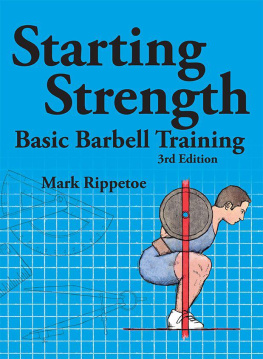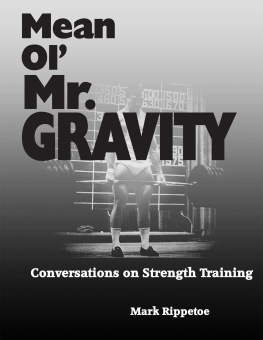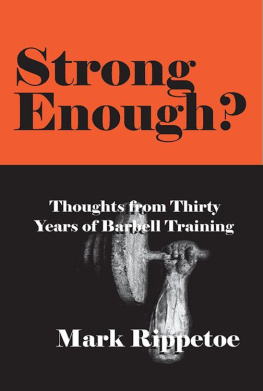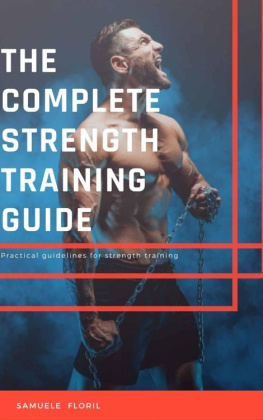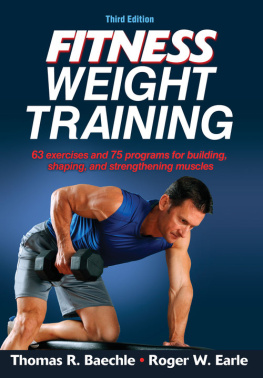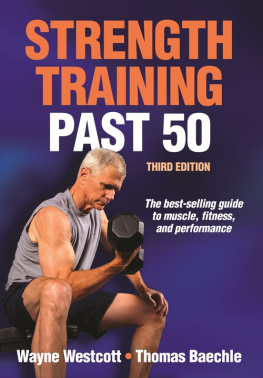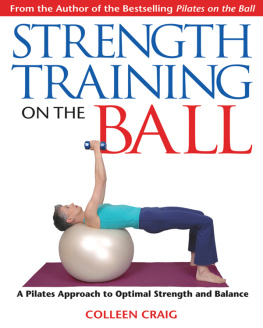Practical Programming for Strength Training
3rd Edition
Mark Rippetoe & Andy Baker
with Stef Bradford
The Aasgaard Company
Wichita Falls, Texas

3rd Edition. Kindle version 1.0
Copyright 2013 by The Aasgaard Company.
First edition 2006. Second edition 2009.
All rights reserved. No part of this publication may be reproduced, stored in a retrieval system or transmitted in a form by any means, electronic, mechanical, photocopied, recorded, or otherwise without the prior written consent of the publisher. The authors and publisher disclaim any responsibility for any adverse effects or consequences from the misapplication or injudicious use of the information presented in this text.
Layout & Proof Stef Bradford
ISBN-13: 978-0-9825227-5-2 (paper)
ISBN-13: 978-0-9825227-6-9 (electronic)
ISBN-10: 0-98252275-4 (paper)
ISBN-10: 0-98252276-2 (electronic)
The Aasgaard Company
3118 Buchanan St, Wichita Falls,TX 76308, USA
www.aasgaardco.com
www.startingstrength.com
Contents
Preface to the Third Edition
Every time a new edition of Practical Programming is released, greater clarity is the objective. The idea that novices, intermediates, and advanced lifters require different programming was essentially heresy when I submitted it to the Strength and Conditioning Journal ten years ago. The piece was rejected by two separate groups of reviewers who insisted that undulating periodization applied to everyone, and that by claiming it did not apply to novices I demonstrated a complete lack of understanding of the Organizing Principles of Science. Some progress has been made since then, and I hope this edition further clarifies the idea that human adaptation follows the same trajectory that all progressive phenomena display on the way to their limit. The book has sold more than 90,000 copies and helped more people get stronger than anything else in print except Starting Strength: Basic Barbell Training.
The first two editions were intended as basic diagrams for designing the readers own programs an outline of the basic principles of stress/recovery/adaptation. The book was designed as a template for the development of programs based on the way people of different levels of training advancement respond to stress. As it turns out, people want details more examples of the specific programs in use for lots of different lifters so here they are.
Stef Bradford PhD is actually the brains and talent behind the upgrade of this material. Youd think far less of my abilities if you knew how big a part of what I do is actually her idea. Our little secret, okay?
As for the detailed programs weve added, Andy Baker is as good at writing them as anybody I know, especially including me. When we decided to flesh out the book, he was my first choice. He has a feel for the numbers and for realistic progressions, and most of these detailed examples are his babies. If you can get him to help you with your training, you should.
Matt Reynolds was my other first choice. Another exceptionally talented programming consultant, Matt is busy with several projects but took the time to provide us with an advanced program in Chapter 8. If Andys busy, call Matt. Or start with Matt if you want to.
Jordan Feigenbaum MD and Jonathon Sullivan MD PhD reviewed several parts of the manuscript for us. Jordan made dozens of valuable suggestions that improved the accuracy and clarity of the first five chapters, and Sully is an exceptionally intelligent and experienced resource for the nuances of human interaction with life and its complications. I count on both of these guys when Im in over my head.
The experience weve acquired over the last 4 years has been facilitated by several important members of the staff of our seminar program. Tom Campitelli (also our staff photographer), Michael Wolf, Steve Hill, Jordan Feigenbaum, Matt Reynolds, Paul Horn, and several others just getting started have created the best possible business environment, where we all learn from each other. Without them, this new edition would not have been possible.
As usual, Mary Conover stopped what she was doing and prepared the index, making this book a much more valuable resource that it would otherwise have been.
My thanks also to you, the readers of our books and participants on the boards. Your valuable feedback has spurred the development of this edition of PPST.
Rip
Wichita Falls, Texas
November 2013
Chapter 1: Introduction
Welcome to the third edition of Practical Programming for Strength Training. This edition will take a slightly different approach to introducing the concept of strength training by first detailing what it is not. Three terms are often used to describe what may or may not happen in the gym: Physical Activity, Exercise, and Training. This book is concerned with the last of these three, so wed better define the first two now, so that Training will be definable separately and at length later.
Physical activity is what The American Heart Association wants you to get some of each week. Physical activity is anything that makes you move your body and burn calories is the quote from their website regarding what they consider to be necessary for continued physical existence. Essentially, not sitting or lying down is physical activity. We are not particularly concerned with this, because even elderly people can take a more productive approach to their physical existence than mere movement for an arbitrarily recommended period of time.
Physical fitness is a related concept. Defined by Kilgore and Rippetoe in 2006 in the Journal of Exercise Physiology Online [9(1):1-10]:
Possession of adequate levels of strength, endurance, and mobility to provide for successful participation in occupational effort, recreational pursuits, familial obligation, and that is consistent with a functional phenotypic expression of the human genotype.
This definition is certainly an improvement upon previous attempts to quantify the concept, in that it is both a framework that remains relevant throughout a lifespan, and a definition based on evolutionary reasoning, i.e. why it is necessary to be fit from a genetic standpoint. The optimum expression of the human genotype is, by this definition, a fit human, and this is satisfying at many levels.
We, however, refuse to stop at this level, because we are athletes. We seek to optimize the expression of physical fitness through means more productive than merely not sitting down, because we are competitive perhaps just with ourselves, but competitive nonetheless. We seek to escalate our physical capacities by means that the AHA would possibly deem excessive, and would certainly not regard as necessary for their purposes, which consist primarily of not dying from a cardiac event.
To this end, Exercise and Training are separate concepts worthy of definition and examination. The terms are often used interchangeably, and this is incorrect. The term workout is used in both exercise and training to denote a scheduled event that produces a physical stress (we dont usually refer to pushing the car when it runs out of gas as a workout, although it may produce the same stress). Exercise and Training both utilize workouts, but the concepts are profoundly different.
Exercise is physical activity performed for the effect it produces today right now . Each workout is performed for the purpose of producing a stress that satisfies the immediate needs of the exerciser: burning some calories, getting hot, sweaty, and out of breath, pumping up the biceps, stretching basically just punching the physical clock. Exercise is physical activity done for its own sake, either during the workout or immediately after its through. Exercise may well involve doing exactly the same thing every time you do it, as long as it accomplishes the task of making you feel like to want to feel today.
Next page

